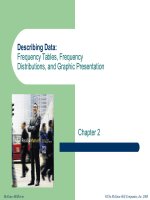Stastical technologies in business economics chapter 13
Bạn đang xem bản rút gọn của tài liệu. Xem và tải ngay bản đầy đủ của tài liệu tại đây (1.43 MB, 56 trang )
Linear Regression and
Correlation
Chapter 13
McGraw-Hill/Irwin
©The McGraw-Hill Companies, Inc. 2008
GOALS
Understand and interpret the terms dependent and
independent variable.
Calculate and interpret the coefficient of correlation,
the coefficient of determination, and the standard
error of estimate.
Conduct a test of hypothesis to determine whether
the coefficient of correlation in the population is zero.
Calculate the least squares regression line.
Construct and interpret confidence and prediction
intervals for the dependent variable.
Regression Analysis - Introduction
Recall in Chapter 4 the idea of showing the
relationship between two variables with a scatter
diagram was introduced.
In that case we showed that, as the age of the buyer
increased, the amount spent for the vehicle also
increased.
In this chapter we carry this idea further. Numerical
measures to express the strength of relationship
between two variables are developed.
In addition, an equation is used to express the
relationship. between variables, allowing us to
estimate one variable on the basis of another.
Regression Analysis - Uses
Some examples.
Is there a relationship between the amount Healthtex
spends per month on advertising and its sales in the
month?
Can we base an estimate of the cost to heat a home
in January on the number of square feet in the
home?
Is there a relationship between the miles per gallon
achieved by large pickup trucks and the size of the
engine?
Is there a relationship between the number of hours
that students studied for an exam and the score
earned?
Correlation Analysis
Correlation Analysis is the study of the relationship
between variables. It is also defined as group of techniques to
measure the association between two variables.
A Scatter Diagram is a chart that portrays the relationship
between the two variables. It is the usual first step in
correlations analysis
–
–
The Dependent Variable is the variable being
predicted or estimated.
The Independent Variable provides the basis for
estimation. It is the predictor variable.
Regression Example
The sales manager of Copier
Sales of America, which has a
large sales force throughout the
United States and Canada,
wants to determine whether
there is a relationship between
the number of sales calls made
in a month and the number of
copiers sold that month. The
manager selects a random
sample of 10 representatives
and determines the number of
sales calls each representative
made last month and the
number of copiers sold.
Scatter Diagram
The Coefficient of Correlation, r
The Coefficient of Correlation (r) is a measure of the strength of the relationship between two variables.
It requires interval or ratio-scaled data.
It can range from -1.00 to 1.00.
Values of -1.00 or 1.00 indicate perfect and strong correlation.
Values close to 0.0 indicate weak correlation.
Negative values indicate an inverse relationship and positive values indicate a direct relationship.
Perfect Correlation
Minitab Scatter Plots
Correlation Coefficient - Interpretation
Correlation Coefficient - Formula
Coefficient of Determination
The coefficient of determination (r2) is the proportion of the
total variation in the dependent variable (Y) that is explained
or accounted for by the variation in the independent variable
(X). It is the square of the coefficient of correlation.
It ranges from 0 to 1.
It does not give any information on the direction of the
relationship between the variables.
Correlation Coefficient - Example
Using the Copier Sales of
America data which a
scatterplot was
developed earlier,
compute the correlation
coefficient and
coefficient of
determination.
Correlation Coefficient - Example
Correlation Coefficient – Excel Example
Correlation Coefficient - Example
How do we interpret a correlation of 0.759?
First, it is positive, so we see there is a direct relationship between
the number of sales calls and the number of copiers sold. The value
of 0.759 is fairly close to 1.00, so we conclude that the association
is strong.
However, does this mean that more sales calls cause more sales?
No, we have not demonstrated cause and effect here, only that the
two variables—sales calls and copiers sold—are related.
Coefficient of Determination (r2) - Example
•The coefficient of determination, r2 ,is 0.576,
found by (0.759)2
•This is a proportion or a percent; we can say that
57.6 percent of the variation in the number of
copiers sold is explained, or accounted for, by the
variation in the number of sales calls.
Testing the Significance of
the Correlation Coefficient
H0: ρ = 0 (the correlation in the population is 0)
H1: ρ ≠ 0 (the correlation in the population is not 0)
Reject H0 if:
t > tα/2,n-2 or t < -tα/2,n-2
Testing the Significance of
the Correlation Coefficient - Example
H0: ρ = 0 (the correlation in the population is 0)
H1: ρ ≠ 0 (the correlation in the population is not 0)
Reject H0 if:
t > tα/2,n-2 or t < -tα/2,n-2
t > t0.025,8 or t < -t0.025,8
t > 2.306 or t < -2.306
Testing the Significance of
the Correlation Coefficient - Example
The computed t (3.297) is within the rejection region, therefore, we will reject H 0. This means
the correlation in the population is not zero. From a practical standpoint, it indicates to
the sales manager that there is correlation with respect to the number of sales calls
made and the number of copiers sold in the population of salespeople .
Minitab
Linear Regression Model
Computing the Slope of the Line
Computing the Y-Intercept









